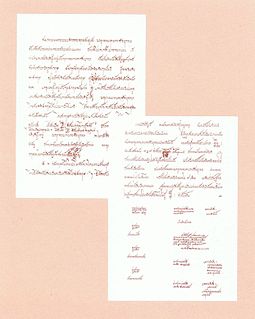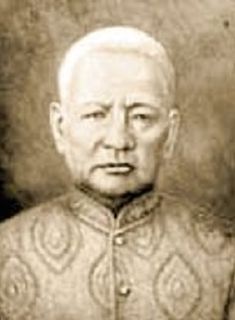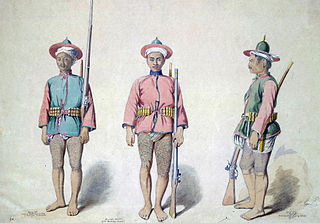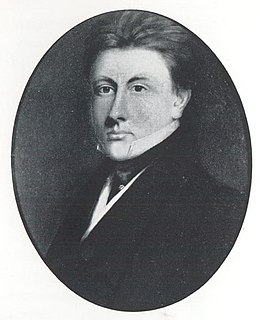| |||||
| Decades: | |||||
|---|---|---|---|---|---|
| See also: | |||||
This article relies largely or entirely on a single source .(February 2020) |
The year 1825 was the 44th year of the Rattanakosin Kingdom of Siam (now known as Thailand). It was the first year in the reign of King Rama III.
| |||||
| Decades: | |||||
|---|---|---|---|---|---|
| See also: | |||||
This article relies largely or entirely on a single source .(February 2020) |
The year 1825 was the 44th year of the Rattanakosin Kingdom of Siam (now known as Thailand). It was the first year in the reign of King Rama III.
This section is empty.You can help by adding to it.(September 2017) |
This section is empty.You can help by adding to it.(September 2017) |

The Tai ethnic group migrated into mainland Southeast Asia over a period of centuries. The word Siam may have originated from Pali or Sanskrit श्याम or Mon ရာမည, probably the same root as Shan and Ahom. Chinese: 暹羅; pinyin: Xiānluó was the name for the northern kingdom centred on Sukhothai and Sawankhalok. To the Thai, the name has mostly been Mueang Thai.

Chulalongkorn, also known as King Rama V, reigning title Phra Chula Chom Klao Chao Yu Hua, was the fifth monarch of Siam under the House of Chakri. He was known to the Siamese of his time as Phra Phuttha Chao Luang. His reign was characterized by the modernisation of Siam, governmental and social reforms, and territorial concessions to the British and French. As Siam was threatened by Western expansionism, Chulalongkorn, through his policies and acts, managed to save Siam from colonization. All his reforms were dedicated to ensuring Siam's survival in the face of Western colonialism, so that Chulalongkorn earned the epithet Phra Piya Maharat.

Chao Anouvong, or regnal name Xaiya Setthathirath V, , led the Lao rebellion (1826–28) as the last monarch of the Kingdom of Vientiane. Anouvong succeeded to the throne in 1805 upon the death of his brother, Chao Inthavong, Xaiya Setthathirath IV, who had succeeded their father, Ong Bun or Phrachao Siribounyasan Xaiya Setthathirath III. Anou was known by his father's regal number until recently discovered records disclosed that his father and brother had the same regal name.

Nangklao or Rama III was the third monarch of Siam under the House of Chakri, ruling from 21 July 1824 to 2 April 1851. He succeeded his father, Rama II, as the King of Siam. His succession was unusual according to the traditions because Nangklao was a son of a concubine rather than that of a queen. His accession was perceived by foreign observers as having usurped the prior claim of Prince Mongkut, who was a legitimate son of Rama II born to a queen, Srisuriyendra. Under the old concept of Thai monarchy, however, a proper king must emulate Maha Sammata in that he must be "elected by the people." Ironically, Prince Mongkut may have later contributed to this misconception, when he feared that his own accession might be perceived by foreign observers as a usurpation.

Phra Phutthayotfa Chulalok Maharaj, born Thongduang and also known as Rama I, was the founder of Rattanakosin Kingdom and the first monarch of the reigning Chakri dynasty of Siam. His full title in Thai is Phra Bat Somdet Phra Paramoruracha Mahachakkriborommanat Phra Phutthayotfa Chulalok. He ascended the throne in 1782, after defeating a rebellion which had deposed King Taksin of Thonburi. He was also celebrated as the founder of Rattanakosin as the new capital of the reunited kingdom.

The Rattanakosin Kingdom is the fourth and present kingdom in the history of Thailand. It was founded in 1782 with the establishment of Rattanakosin as the capital city. This article covers the period until the Siamese revolution of 1932.

Phra Phutthaloetla Naphalai or Rama II was the second monarch of Siam under the Chakri dynasty, ruling from 1809 to 1824. In 1809, Itsarasunthon succeeded his father Rama I, the founder of Chakri dynasty, as Loetlanaphalai the King of Siam. His reign was largely peaceful, devoid of major conflicts. His reign was known as the "Golden Age of Rattanakosin Literature" as Loetlanaphalai was patron to a number of poets in his court and the King himself was a renowned poet and artist. The most notable poet in his employ was the illustrious Sunthorn Phu, the author of Phra Aphai Mani.
The Anglo-Siamese Treaty of 1909 or Bangkok Treaty of 1909 was a treaty between Great Britain and the Kingdom of Siam signed on 10 March 1909, in Bangkok. Ratifications were exchanged in London on 9 July 1909, and the treaty established the modern Malaysia–Thailand border. The area around modern Pattani, Narathiwat, southernmost Songkhla, Satun, and Yala remained under Thai control, where decades later the South Thailand insurgency would erupt. Thailand relinquished its claims to sovereignty over Kedah, Kelantan, Perlis and Terengganu which entered the British sphere of influence as protectorates. These four states, along with Johor, later became known as the Unfederated Malay States.

Paramanuchitchinorot was a Buddhist writer and a prince of the Chakri dynasty. One of his well-known epic poems is Lilit Taleng Phai. In 1851 he was appointed the Supreme Patriarch of the Rattanakosin kingdom and remained in that position until his death.

The treaty between Kingdom of Siam and Great Britain commonly known as the Burney Treaty was signed at Bangkok on 20 June 1826 by Henry Burney, an agent of British East India Company, for Britain, and King Rama III for Siam. It followed an earlier treaty of 24 February 1826, in which Siam became an ally of Britain against the Kingdom of Ava (Burma), with which Britain was at war. A Siamese army was raised and equipped, but took no serious part in the war due to ill-feeling and suspicion arising from the Siamese invasion of Kedah in 1821.

The Lao rebellion, also known as Anouvong's Rebellion or Lao–Siamese War, was an attempt by King Anouvong of the Kingdom of Vientiane to end the suzerainty of Siam and recreate the former kingdom of Lan Xang. In January 1827 the Lao armies of the kingdoms of Vientiane and Champasak moved south and west across the Khorat Plateau, advancing as far as Saraburi, just three days march from the Siamese capitol of Bangkok. The Siamese quickly mounted a counterattack, forcing the Lao forces to retreat. The Siamese continued north to defeat Anouvong's army. His rebellion had failed, which led to his capture, the destruction of his city of Vientiane in retaliation, a massive resettlement of Lao people to the west bank of the Mekong River, and direct Siamese administration of the former territories of the Kingdom of Vientiane. The rebellion was a watershed moment in the history of Southeast Asia, as it further weakened the small Lao kingdoms, perpetuated conflict between Siam and Vietnam and ultimately facilitated French involvement in Indochina in the latter half of the nineteenth century. The legacy of the Lao rebellion is controversial. It is viewed in Thailand as a ruthless and daring rebellion that had to be suppressed, and has given rise to the folk heroes such as Thao Suranari and Chao Phaya Lae. In Laos, King Anouvong is now revered as a national hero who died in pursuit of complete independence, even though he both lost his life in an ill-advised revolt against heavy odds and virtually guaranteed that the Lao-speaking provinces across the Mekong River would remain as part of Siam.
Henry Burney or Hantri Barani in Thai, was a British commercial traveller and diplomat for the British East India Company. His parents were Richard Thomas Burney (1768–1808), headmaster of the Orphan School at Kidderpore, and Jane Burney (1772–1842), and he was a nephew of the English writer Frances Burney (1752–1840). On 30 June 1818 at St. George's Church in George Town, Penang, Malaya, he married Janet Bannerman (1799–1865), with whom he had 13 children, eight of whom were still living at the time of his death. She was the niece of John Alexander Bannerman, who was governor of Penang in Malaya.

Somdet Chao Phraya Borom Maha Prayurawongse or Tish Bunnag was a prominent political figure of Siam during the mid-19th century as a regent for King Mongkut kingdom-wide. He became a Somdet Chao Phraya — the highest rank a Siamese noble had attained during the Rattanakosin Era, with honor equal to that of royalty. He was known colloquially as Somdet Chao Phraya Ong Yai. He was also known as Chao Phraya Phraklang, or Minister of Trade, and dominated Western affairs of Siam during the reign of King Rama III. He held the post of Samuha Kalahom, the Prime Minister of Southern Siam, from 1830 to 1855.

The Siamese invasion of Kedah was a military operation mounted by the Kingdom of Siam and its ally the British against the Sultanate of Kedah in November 1821, in the area of what is now northern Peninsula Malaysia.

The Burmese–Siamese War of 1849–1855 was a war between the Burmese Konbaung Dynasty and the Siamese Rattanakosin Kingdom, the last of twenty wars fought between the Burmese and the Siamese between the 16th and 19th centuries. The war was the result of attempts by the Siamese to recapture much of the land they had lost to the Burmese in previous wars, as well as make reality their claims in the trans-Salween region of Myanmar that had been contested for hundreds of years. After heavy fighting, the Burmese drove the Siamese out of Shan territory, ending realistic Siamese hopes of reclaiming the territory.
The year 1850 was the 69th year of the Rattanakosin Kingdom of Siam. It was the twenty-seventh year in the reign of King Rama III.
The year 1851 was the 70th year of the Rattanakosin Kingdom of Siam. It was the 28th and last year in the reign of King Nangklao, and the first year in the reign of King Mongkut.

Wongsa Dhiraj Snid was a Thai physician and diplomat, as well as a member of the reigning Chakri dynasty. An early adopter of Western-style medicine, he was the court physician for much of his life, and was known as the "Doctor Prince."

Robert Hunter was a British merchant and unofficial diplomat in Siam during the reign of King Rama III. Hunter settled in Bangkok in 1824 and served as an intermediary between Westerners and the court until his departure from the country in 1844 over a trade dispute with the king.
Chao Phraya Nakhon Si Thammarat, personal name Noi Na Nagara, was the governor of Nakhon Si Thammarat or Ligor from 1811 to 1838 and a son of King Taksin. He had important roles in the relations between Siam and the Sultanate of Kedah during the nineteenth century. His modern descendants bear the surname Na Nagara, Komarakul Na Nagara and Chaturangakula. Chao Phraya Nakhon Noi was known in Malay sources as Phya Buri Sakmuton and in contemporary British sources as the Raja of Ligor.
| This article related to the history of Thailand or its predecessor states is a stub. You can help Wikipedia by expanding it. |
| This year in Asia article is a stub. You can help Wikipedia by expanding it. |